How Can Luxury Brands Prepare for Gamification of the Chinese Market with the Help of Social Media?
September 25,2019
Gamification is one of the hottest topics in todayтs fashion industry. The main forms of gamification are points, leveling up, and ranking, etc. Gamification applies the elements and rules of games to marketing scenarios (products or services), and brands can use it to improve the user experience, while simultaneously improving brand awareness.
Gamification marketing in China is reliant on social ecosystems
In most markets brands tend to spend a lot of energy and money on gamification marketing; for example, Nike launched a fitness app for its customers, while Louis Vuitton especially developed an app to promote its foundation and art exhibitions. The Chinese market may be the exception in terms of brand digitization and gamification in the global market because it is common practice to rely on local social marketing such as WeChat advertising and Mini Programs instead of apps.
WeChat advertising and Mini Programs make it easier for luxury brands to be more flexible and attempt local marketing, with interactive games to build closed-loop marketing. Nike's latest WeChat marketing plan, "Nike Air Represents the Retro Future", amplifies its social influence by advertisements being placed directly in WeChat Moments. Through WeChat Moments advertising, users can directly click into the Nike Mini Program to complete their purchase.
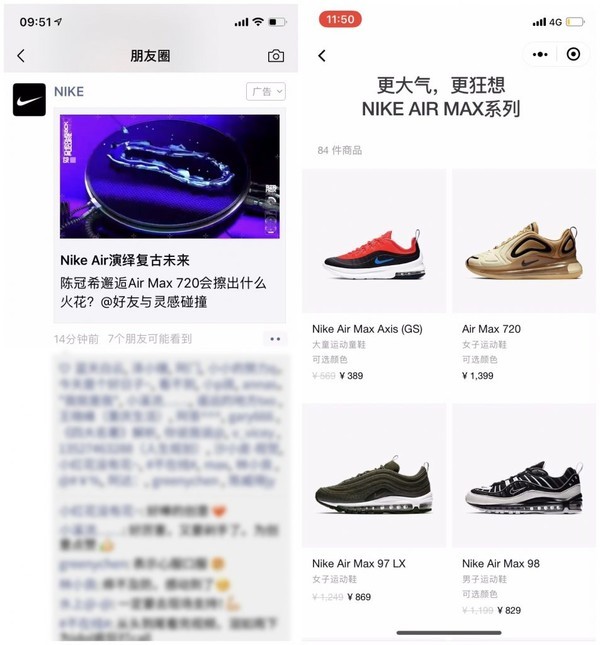
( Image above: Nike WeChat Moment ads )
Unlike in other markets, when Louis Vuitton needed to make an app for the exhibition тVolez Voguez Voyagezт earlier this year in Shanghai, it chose to use the WeChat Mini Program that integrates several functions, such as exhibition reservation, exhibition map, voice guide and interactive experience (the functionality of this app was no less than that of an independent app), which helped the brand to attract, retain and activate more users.
Today, WeChat has 1,112 million monthly active users, and the WeChat Mini Program has become the first choice for gamification marketing. Compared to traditional time-consuming and costly methods, such as building an independent online shop or app, a WeChat Mini Program can be created within a few weeks. It is not only lightweight and efficient with a low customer cost, but also offers a high degree of flexibility and strong autonomy. From WeChat advertising to brand awareness, a brand is able to more easily undertake the last step of sales conversion and achieve closed-loop marketing with WeChat Mini Programs.
Based on a report on WeChat E-commerce Mini Programs by the retail strategy consultancy firm, Azoya Consulting, the number of WeChat Mini Programs reached 2.3 million in 2018 (18% of them are e-commerce programs), with 230 million daily active users, and a per capita use frequency of 4 times a day. The average transaction amount of a Mini Program is around 200RMB, as shown in the figure below.
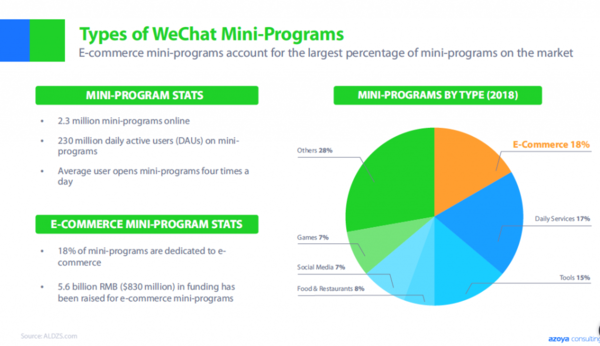
Four categories, analysis of Mini Program + WeChat Moments Advertising
China, as one of the most important markets of the fashion and luxury industry, is an opportunity that cannot be ignored by major brands. WeChat is an unavoidable and incredibly important channel for luxury brands who hope to reach consumers through social media in China, and build more gamification experience for their users.
In the following, we have summarized and categorized creative marketing efforts from global luxury brands based on WeChat moments advertisements and Mini Programs in recent years into four categories. Through specific case analysis, we will show how these WeChat Moments advertisements and Mini Program improve user engagement through gamification and help achieve efficient closed-loop customer transformation.
1.Replacement of physical gift cards with Wechat Mini Programs
Case study: Dior gift card
It is traditional in China to give gifts to each other on festive occasions. During the Qixi festival last year, Dior released an advertisement of Qixi gift card in their WeChat Moments. Users were able to purchase gift cards through the Mini Program and share or give them to their friends. For Dior, this form not only provides users with more abundant gift options, but also solved the problem that gift cards are difficult to promote efficiently offline -- by relying on WeChat's in-depth understanding of users and data capabilities, Dior was able to reach users multi-dimensionally and lead them to purchase gift cards online.
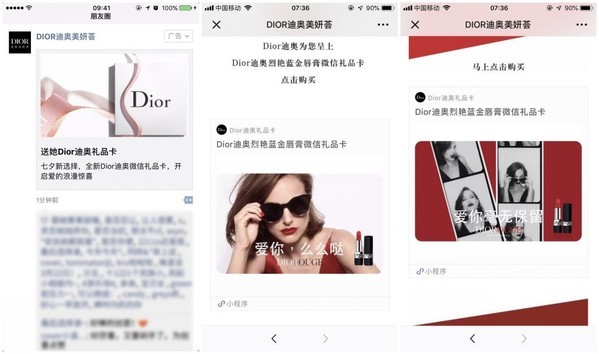
2.Special Customized products for festivals
Case study: Bottega VenetaуCalvin Klein уYSL
During the Qixi festival in 2018, Bottega Veneta pushed a customized activity of dating letters to users through ads on WeChat Moments. Recipients not only receive a recorded voice wished from their friends, but also get a chance to buy Qixi limited products.

Calvin Klein also launched an exclusive underwear customization service during the Qixi festival. Users were able to choose the style, color and size of underwear, as well as customizing patterns and constellations.
YSL promoted a lipstick appearance customization activity through ads in their WeChat moments. This attracted a large amount of user participation. At that time, its rate of people giving likes was 280% higher than the industry average, and its rate of people leaving comments was 8 times higher than the industry average. Indeed, the two most expensive gift boxes sold out in half a day!

According to "China New Generation Fashion Consumption Report 2018т released by Luxe.CO, about 20% of the new generation of consumers want brands to provide a personalized customization service experience in stores. However, it is too costly for brands to provide customized services for users in each store and it is not easy to implement promotion -- WeChat Mini Programs and WeChat Moments advertising can provide more flexible alternatives for brands.
3.Leading existing users to offline activities by re-posting WeChat Moments ads to them
Case study: Estee Lauder new product promotion
After reaching potential users online,Т retention and engagement of users and driving them towards offline channels is a problem that many brands have been thinking. When planning marketing strategies, offline experience (especially for beauty brands) continues to be very important.
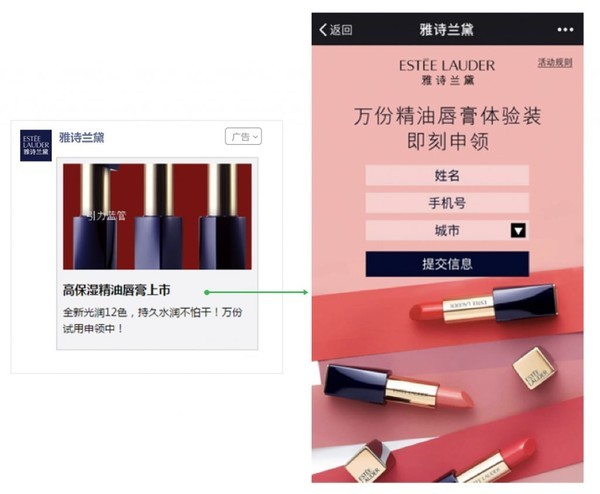
In the past year, many users have received event invitations from Estee Lauder on Wechat Moments, and booked the free trial experience through WeChat. This method has become one of the daily marketing methods of Estee Lauder, and in the process of resending ads to the existing users on WeChat Moments, Estee Lauder also collect more user insights from more dimensions.
4.Creative ads link Mini Programs, achieve closed-loop sales transformation
Case study: M.A.C. and LancУДme creative content marketing
At the beginning of 2019,Т M.A.CТ andТ Honor of KingsТ (Т чш
шЃшТ ) co-launched limited edition bullet lipstick. In order to expand the marketing effect and transformation, the brand, through advertising on WeChat Moment, also specially created an activity page on Mini Program for this joint activity.
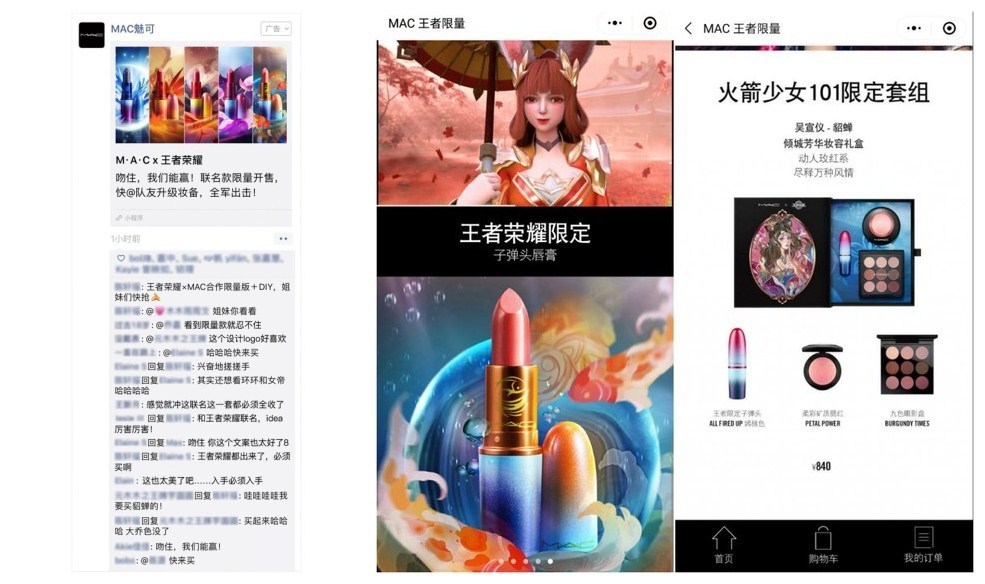
During the Chinese New Year, LancУДme's Chinese-themed red interactive ads attracted a lot of user participation. Users were able to draw a heart on the screen and automatically open the Easter Egg page to receive a gift code.
More and more beauty brands are using "Creative Content + WeChat Moments + WeChat Mini Program" to create a more diverse and interesting consumption scenarios, with the ultimate goal of effectively achieving closed-loop transformation. This approach is also a good solution for the public account content which is difficult to directly transform into sales.
Conclusion
In the above four categories, luxury brands have greatly reduced the cost of customer acquisition by fully using the functions on WeChat, such as mini-game experience, gift cards, customization service and WeChat payment, etc., and to maximize effectiveness of gamification marketing in China. The last and most important is to expand the brand new marketing and sales channels.
WeChat, as a unique social platform in China, provides different tools and functions for brands. Relying on its huge user base and ultra-high interaction function, brands are able to keep accumulating and operating its own digital assets, strengthen brand autonomy, and help its analysis to gain deep insight of consumers, which ultimately translates into its own business value.












Comments